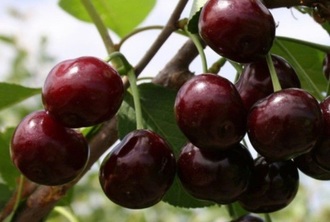Content
- 1 The best varieties of red early raspberries
- 2 What are the most productive varieties of late raspberries
- 3 The best new varieties of large-fruited remontant raspberries
- 4 What are the varieties of yellow raspberries
- 5 The best remontant varieties of raspberries
- 6 The best classic raspberries
- 7 The best standard raspberry varieties
- 8 1. Hercules
- 9 2. Patricia
- 10 3. Bryansk miracle
- 11 4. Bristol Black
- 12 5. Eurasia
- 13 6. Crane
- 14 7. Senator
- 15 8. Fantasy
- 16 9. Scheherazade
- 17 10. Maria
- 18 11. Golden Autumn
- 19 12. Golden domes
- 20 13. Orange miracle
- 21 14. Cleopatra
Among them, gardeners can choose the best to their taste: early or late, high-yielding or remontant, with berries of red, yellow and even black. Find out which raspberry varieties are most popular in hobby gardening.
The best varieties of red early raspberries
"Balm". Slightly spreading bush, medium height, medium shoot-forming ability. The berries of this early raspberry variety are conical, dark raspberry with slight pubescence, sweet and sour taste with aroma.
"Modest". The bush is medium, slightly spreading. Berries are hemispherical, dark raspberry color, sweet and sour taste, no aroma.
"Companion". The bush is erect, high. The berries of this are one of the earliest varieties of hemispherical raspberries, dark raspberry color, sweet and sour taste.
"Crane". Variety of medium early ripening, remontant. Slightly spreading bush, erect, powerful shoots. Berries are large, conical, raspberry, sweet and sour taste with aroma.
"Hussar". The bush is tall, powerful, does not need support, there is little overgrowth. This is one of the best early raspberries with elongated ruby red berries, sweet and sour taste and amazing aroma.
"Sun". The berries are large, rounded-conical, crimson in color with delicate fragrant pulp.
"Patricia" - the most interesting among large-fruited raspberry varieties with attractive, beautiful berries. The berries are large, individual up to 14 g, truncated-conical in shape, with a beautiful velvety surface, of medium density, they are removed from the fruit plant without breaking, when fully ripe they do not crumble for a long time. The taste of berries is sweet with a pleasant "raspberry" aroma, juicy melting pulp and a few small seeds. Productivity of 4-5 kg per bush. Fruiting annually, early ripening variety. One of the most productive varieties. Plants are medium-sized (up to 1.8 m), non-repaired, semi-sprawling, annually form 6-10 replacement shoots and 5-7 root suckers.
"Maroseyka" - the first domestic thornless variety with very large berries (up to 12 g) and high yield (4-5 kg per bush). Some of the red berries of this raspberry variety are double, conical. The taste of berries is sweet with a pleasant aroma. Fruiting annually, medium-early ripening variety. Bushes about 1.5 m tall, spreading, powerfully developed, not repaired.
"Aboriginal" - an early variety for areas of the non-chernozem zone. Differs in a high yield, large (4-8 g) bright red berries. The berries are conical, well-formed, easily removed from the fruit-bearing.
What are the most productive varieties of late raspberries
Below it is described which varieties of late raspberries are the most productive, and therefore are the most popular.
"Brigantine". Berries are dark raspberry, dense, round-conical in shape, good taste.
"Tarusa" - the first domestic variety with standard-type shoots, strongly thickened, hard and tough. Bushes practically do not require supports, but still the harvest is better obtained with a trellis.The berries of this fruitful variety of raspberries are large (up to 12 g), blunt-conical, bright red in color, shiny, well removed from the fruit-bearing. The berry taste is sweet with a pleasant raspberry aroma. Productivity of 3-4 kg per bush. The bushes of this variety are of medium height (about 1.5 m), compressed type, powerfully developed, non-repairable, form 8-10 replacement shoots and 4-5 root suckers each, do not creep over the site.
"Arbat" - among the new large-fruited varieties of raspberries, it stands out for the abundance of very large berries with a mass of 15-18 g and more. The berries are elongated and conical, dark red in color, shiny, removed from the fruit plant without breaking. The taste of berries is sweet with a pleasant raspberry aroma, juicy melting pulp. Productivity - up to 9 kg per bush. Plants of this one of the most productive varieties of raspberries are medium-sized (1.5-2, Ohm in height), spreading, powerfully developed, non-repairable.
"Hercules". This variety of raspberries has a medium-sized and slightly spreading bush, shoots are strong, upright, you can do without trellises when growing. Annual shoots are green in spring, and by autumn they acquire a purple hue with a waxy bloom. The thorns are hard, thin and prickly. Autumn harvest in the middle lane reaches 1.5 kg per bush. The first fruits appear on the bushes in early August. Fruiting lasts until the first frost. The fruits of this variety are very large, the average weight of one berry is 5 g, the maximum reaches 10 g. The berries have a truncated-conical shape. The color of the berry is ruby, the taste is sweet and sour.
"Daughter of Hercules". A high-yielding variety with very large tasty berries, weighing 8-10 g. Some berries reach a weight of 20 g.
As you can see in the photo, this ort of raspberries has berries of an elongated-blunt-conical shape, dense, well-transportable:
The bush is medium-sized, the shoots are highly branched. Requires little support.
"Firebird". Large-fruited, high-yielding variety with bright red berries. A distinctive feature is high drought resistance and heat resistance.
"Calendar". This variety is sometimes called the "raspberry tree" for its powerful shoots and bush as a whole. Do not creep over the site. Recommended for growing in all horticultural zones of the European part of Russia.
"Beauty of Russia". It bears fruit with a very tasty berry and has a medium-early ripening period. Berry weighing up to 12 g. This one of the best varieties of raspberries has a smooth trunk and bears fruit well in a sunny area, does not like thickening. Highly productive with good care. These berries can not only be eaten from the bush, they can be admired.
"Stolichnaya" - a late variety of raspberries, high-yielding, distinguished by powerful shoots without thorns. The berries are large (4-8 g), homogeneous, well removed from the fruit plant. When ripe, 3-4 days do not crumble.
The best new varieties of large-fruited remontant raspberries
Here you can find photos and descriptions of remontant type raspberry varieties.
"Indian summer". The first domestic cultivar of remontant raspberry with predominant fruiting on annual shoots.
"Apricot". Amber fruits with a pink blush have an apricot flavor. Such amazing berries delight not only children, but also seasoned adults. This raspberry begins to ripen in August and bears fruit until frost. During the summer-autumn period of fruiting, gardeners manage to collect up to 4 kg of berries. Semi-spreading bushes, medium height. Thorns are located mainly in the lower part of the shoots, so they do not interfere with caring for the plant and harvesting at all.
"Bryansk Marvel". The variety of this raspberry has a medium-sized and compact bush, which reaches a height of 1.6 m. Fruiting is abundant, fruits are large, up to 6 g. The berries have a graceful elongated-conical shape with a pleasant taste and delicate aroma. They separate well from the stalk. Up to 5 kg of raspberries are harvested from the bush. The first crop is harvested in July, and the second - from mid-August until the first frost.
"Taganka" - early variety, high-yielding, large-fruited. Numerous thorns on the shoots.The berries are large (4-8 g), conical. The grade is remontant. The berries of the autumn harvest are also very large (up to 6 g).
"Kalashnik" - a remontant variety, which is used exclusively for obtaining an autumn harvest.
"Pride of Russia". This one of the best varieties of remontant raspberry is distinguished by its large and attractive berries. Weight reaches 12 g, individual berries can reach 18 g. Fruits have a conical and blunt-conical shape with a velvety surface. The berries are easily removed from the stalk and, when fully ripe, do not crumble.
The taste is sweet, light and pleasant aroma. The berries are juicy and have small seeds. Up to 5 kg of fruits are harvested from each bush. Bears fruit every year. The variety ripens on July 8-10, therefore it is considered medium early. The bush of this variety is medium-sized and compact. The variety is not remontant.
"Cap of Monomakh". The variety is remontant, has a low bush in the form of a small tree, which forms several slightly drooping, highly branched shoots. The variety is distinguished by large fruits (up to 7 g) of ruby color, elongated blunt-conical shape. The berries come off well from the stalk, ripen in mid-August and bear fruit for a long time. You can collect 5.5 kg of berries from a bush. However, before the first frost, not all berries have time to ripen. The first crop is harvested in July, the second from mid-August until the first frost.
"Giant" considered one of the best varieties for cultivation in summer cottages. This is a new variety of raspberries that has a distinctive feature: it lacks thorns. The weight of the fruits of this one of the best varieties of large-fruited raspberries can be 25 g. The yield of one bush reaches 12 kg, of course, subject to all the rules of agricultural technology.
Atlant - one of the best varieties of remontant raspberries with very tasty and aromatic berries. Moreover, even cold and rainy weather does not negatively affect the taste of the berries. The first berries ripen in mid-August, and then the yield goes very quickly. By mid-September, up to 5 kg of fruit can be harvested from one bush with good care.
"August miracle" - remontant raspberry variety forms a low compact bush, consisting of 7-8 upright shoots. The berries are formed almost along the entire length of the shoot, large, weighing up to 4 g, excellent taste with a delicate aroma. High productivity - 4 kg per bush.
"Penguin". The variety got its name for the standard type of bush. Strong shoots with shortened internodes, does not require additional support (bush height 1.1-1.4 m). The variety is remontant, fruitful, one of the earliest ripening, until mid-September the harvest has time to ripen completely. The berries are large, 6-8 g, round-conical, dark crimson. After ripening, they can hang on the bush for 5-6 days without decaying.
"Eurasia". A variety with a ripening period in the first decade of August. Large berries with good taste. Raspberry-like fruiting of medium vigor.
What are the varieties of yellow raspberries
"Orange miracle". This remontant variety has large berries (10-12 g) of golden yellow color and elongated conical shape. The bush reaches a height of 1.6 meters. The thorns are soft and short. The bush of this yellow raspberry variety does not require support. The variety is high-yielding, which is usually not characteristic of yellow-fruited varieties.
"Golden autumn". Large-fruited, remontant variety with bright golden yellow berries. The berries are large, 5-7 g, individual up to 11 g, beautiful, elongated-conical, dense. Dessert-flavored berries with a persistent raspberry aroma. The yield is high. Resistant to diseases and pests.
"Yellow Miracle". Exceptionally productive remont variety, with large (6-8 g) yellow berries, Good dessert taste. The variety is vigorous, the shoots are thick and strong, but requires support. Differs in late onset of autumn fruiting (first decade of September). It is best used as a variety combining summer and autumn harvests.
"Yellow giant" considered the largest among all raspberry varieties. The sweet fruit reaches the size of a walnut. The bushes grow crowded, up to 2.5 m in height. In the fall, the upper part of each shoot is cut off at a height of two meters. With this technique, you can achieve the formation of larger fruits. The shoots are strengthened on a trellis.
Now watch the video "Raspberry Varieties" to get a better idea of what shrubs and berries look like:
Certain varieties of raspberries are a mandatory attribute of a Russian garden. The sweet aromatic berry is not inferior to strawberries in popularity, taste, useful properties, adequately taking over the berry season from it. And raspberry jam has long become a favorite delicacy, the best medicine for colds and the standard of taste characteristics.

The best summer treat!
Traditional varieties of forest shrubs have been cultivated for more than 500 years, but professional gardeners and amateurs are primarily interested in a new assortment - high-yielding, large-fruited, with improved taste and aroma.
Raspberry classification
Before considering the most valuable and interesting varieties of raspberries with photos and descriptions, we propose to understand their diversity and classification. This will help you choose planting material based on economic needs, personal preferences, and climatic features of the region.
By the way of fruiting
Depending on which shoots - the first or second year of the growing season - fruits appear, summer and remontant raspberries are distinguished.
Summer variety has a two-year development cycle. In the first year of the growing season, flower buds are laid in the axils of the leaves, in the second, fruit branches grow from them. The plant begins to bear fruit in June, extending the yield by 1–1.5 months. The main problem, especially in regions with cold winters, is to keep the first-year shoots from freezing.
On the lips of summer fruitful varieties of raspberries - Gusar, Maroseyka, Lashka, Octavia, Glen Ample, Kaliningradskaya.
Repair raspberry, in contrast to the summer, the full growing cycle from regrowth of a young shoot to fruiting takes one year. If you keep the fertile branches, the next year it will give two harvests - in the summer on the old and in the fall on the young shoots. In the middle lane, it is recommended to grow it in an annual crop, getting one, but bountiful harvest. Repaired cultivars are large-fruited, high-yielding, subject to complete pruning for the winter, so they do not need shelter.
The most popular remontant varieties: Diamond, Hercules, Daughter of Hercules, Eurasia, Polka, Polana, Ruby necklace, Indian summer, Penguin.
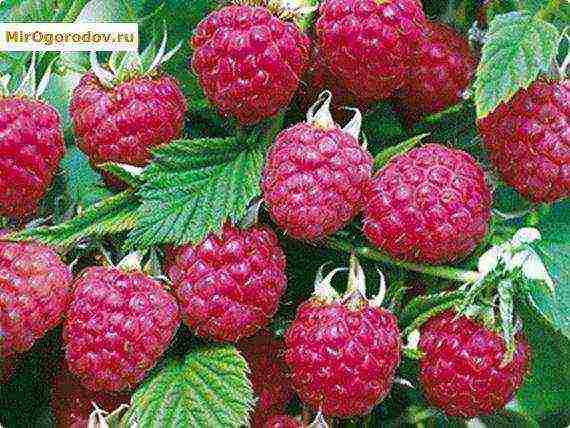
Repaired Raspberry Ruby Necklace
It is interesting! The old Russian variety Novost Kuzmina, developed at the beginning of the 20th century, still remains the standard of raspberry taste. On its basis, more than a dozen new large-fruited cultivars have been bred, including Indian Summer, Bryansk, Vera, Korallovaya, Malakhovka, Meteor, Solnyshko.
By maturity
The earliest varieties of raspberries begin to ripen in the second half of June, and later remontant ones delight with juicy berries until frost.
- Beglyanka, Vera, Lazarevskaya, Novost Kuzmina, Lashka, Glen Ampl are beginning to mature first.
- The mid-early group includes the varieties Blestyuschaya, Gusar, Maroseyka, Balsam, Yellow giant, Canby.
- They have late ripening periods: Firebird, Golden Autumn, Ruby, Coral, Brigantine, Terenty.
By berry size
Distinguish between traditional and large-fruited varieties of raspberries:
- A common raspberry weighs 2.5–4 g and has a sweet taste. The advantage of traditional varieties is their hardiness and unpretentiousness. They rarely freeze out, grow on the most common soils, and are undemanding to care. And although their harvest is small, it is stable from year to year, the quality of the berries is high. An example is Novosti Kuzmina, Beglyanka, Meteor, Kaliningradskaya.
- Increasingly, gardeners want to grow large-fruited varieties. They have a lot of advantages - large berries up to 15 g with a delicate taste and aroma, high yield, density and transportability. The largest-fruited group includes: Arbat (15-18 g), Daughter of Hercules (up to 15 g), Ruby Necklace (12-14 g), Ruby Giant (up to 11 g), Patricia (up to 14 g), Yellow giant (up to 10 g).
By berry color
In the palette of raspberries, there are many shades of red, there are yellow-fruited varieties (Beglyanka, Golden Giant, Apricot, Yellow Giant), with an orange color (Orange Miracle) and even black (Cumberland, Litach).

Chokeberry Cumberland
Standard plants
When choosing a raspberry variety, gardeners often pay attention to the height of the shoots, their stability, or, conversely, the tendency to lodging, the need for a garter. In this regard, standard varieties of berry bushes are popular. Raspberry of the standard type grows up to 1.5 m in height, has a thick and strong stem, is distinguished by increased formation of lateral shoots (for this property it is compared to a raspberry tree), does not require a garter.
Popular standard varieties: Tarusa, Eurasia, Skazka, Krepysh, Monomakh's Hat.
It is interesting! Along with domestic varieties, raspberries of foreign selection are grown in Russia. The most demanded are English cultivars Glen Ample, Glen Prosen, Molling Promis; Polish - Polana, Polka, Lashka; German - Visluha, Kaliningrad; American - Canby, Latham.
10 best varieties for the middle lane
Speaking about the best varieties of raspberries for central Russia, we rely on the opinion of amateur gardeners and the recommendations of the professional community in terms of zoning.
Maroseyka
One of the best summer varieties, bred more than 40 years ago, but has not lost the love of gardeners. Large, with a true raspberry flavor, unpretentious, fruitful. Although the variety is not a standard variety, its stems are thick, strong, erect, and branch well. Maroseyka has no thorns and gives enough replacement shoots (8–9). The berry is light red, conical in shape, sits tightly on the stalk, weight from 4 to 10 g. On good fertilized soil, up to 5 kg of berries can be obtained from the bush. For the winter, it is advisable to cover the planting, in the spring it is imperative to feed it.
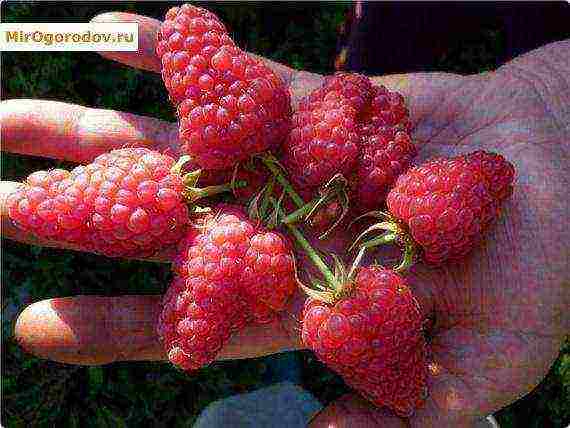
Maroseyka is a berry with the taste of childhood!
Lashka (Lyashka)
This is an early summer variety of Polish selection with large (average 6 g), sweet berries. Fruiting on two-year-old shoots reaching a height of 2 or more meters, so it needs a garter. Fruit branches are literally covered with beautiful bright red oblong berries, which begin to ripen from mid-June. Among the advantages of Lashka, winter hardiness, but she is demanding on the soil, on the fertility of which the size of the berries depends. With appropriate agricultural technology, it surpasses the popular summer varieties Gusar and Meteor in yield.
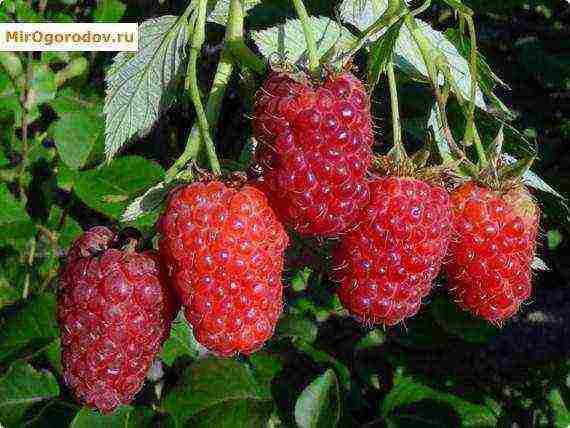
Fertile Lashka
Sun
Another early summer raspberry variety, it is resistant to diseases, not prone to freezing. Forms a powerful bush up to 2 meters high with small thorns. The berries are round, large (up to 5 g), purple in color, with a pleasant dessert taste and aroma. The sun has great vigor of growth, quickly grows stems, gives many replacement shoots (up to 20 pieces), which allows you to quickly propagate the plantation.
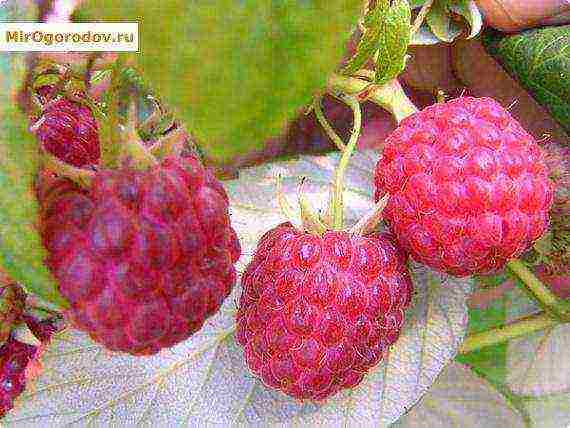
The sun is a descendant of a domestic aborigine Novosty Kuzmina
Pride of Russia
Among summer garden forms, the mid-early Pride of Russia stands out for its attractive characteristics. Forms medium-sized compact bushes with a large number of side shoots. Each fruit twig is a bunch of 25-30 red velvety berries with a dessert flavor. Due to their large size (10–15 g), 4–5 kg of vitamin crop are harvested from each bush. Shoots of the first growing season can withstand frosts up to 30⁰C; in colder climates, it is better to cover them for the winter.

The real Pride of Russia!
Hercules
One of the best remontant raspberry varieties for central Russia.When grown in an annual culture, it begins to ripen in early August and before the cold weather it manages to give 80–90% of the harvest. Bushes are strong, erect, can be grown on a trellis or without support. Large ruby berries weighing 6–10 g abundantly cover the upper third of the fruiting shoot, taste pleasant, sweet and sour. Fruiting is amicable, the yield from one bush is up to 2.5 kg. Plus Hercules in resistance to diseases and dense fruits that do not decay after ripening. More information about the variety in the article "Hercules" and "Hercules' Daughter" raspberry varieties.
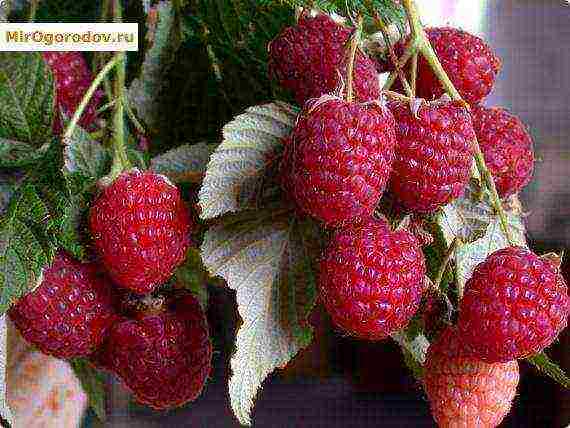
Hercules and his heiress Daughter of Hercules
Monomakh's hat
A new, but already recognized, remontant grade of the standard type. It forms a bush of highly branching shoots, each stem looks like a small tree, does not need support. At the time of fruiting, the bushes, strewn with large ruby berries, look very attractive. The weight of one berry is up to 10 g, and the collection from a bush is 5 kg and this is not the limit. To ensure the maximum summer-autumn yield, the crop is recommended to be grown in a one-year growing cycle.

Ruby Beauty Monomakh Hat
Bryansk miracle
A worthy representative of the domestic school of selection, a remontant variety, which, despite the rather late ripening period (from the second decade of August), manages to give 90% of the harvest before frost. His bushes are squat, stems are thin, so they are recommended to grow on a trellis. The berry is dense, oblong, large (10–12 g), light red in color. The variety is quite demanding on soil fertility - in order to get the predicted yield of 4–5 kg from a raspberry bush, plantings must be fed several times per season.
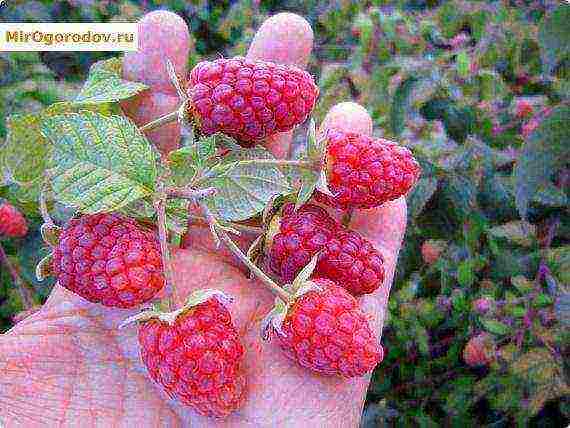
In the photo Bryansk marvel
Yellow giant
Yellow-fruited representative of the large raspberry family. The plant is large-fruited, medium early, bearing fruit once on the shoots of the second growing season. Forms a powerful spreading bush, grows strongly and quickly. The berries are juicy, sweet, weighing 4–8 g, begin to ripen in July and bear fruit until late summer - early autumn. Productivity depends on soil fertility and starts from 3 kg from a raspberry bush. A variety for amateur gardening, as the berry is very soft and cannot be transported.
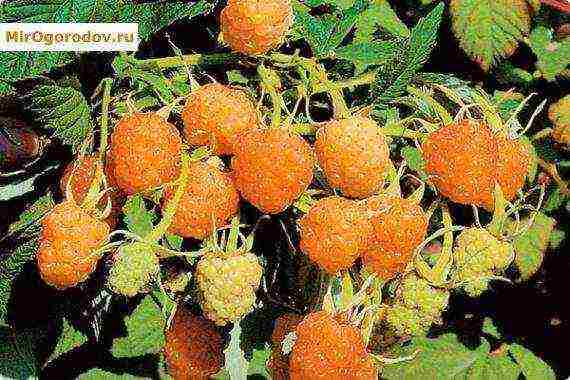
Yellow Giant's amber outfit
Shelf (Polka)
Repaired Polish variety, in demand in amateur gardening. Raspberries begin to ripen in the second half of July and by the end of September they give up almost the entire harvest. The brilliant ruby berry resembles a thimble in shape, the average weight is 4–5 g, in the fruit cluster there are 8–10 pieces. The taste deserves special attention - dessert, with a delicate aroma and balanced sugar. The stems can lie under the weight of the fruits, so it is best to grow the Shelf on a trellis. The variety is not frost-resistant, but this problem can be solved when grown in an annual culture - the shoots are cut on a stump in winter.
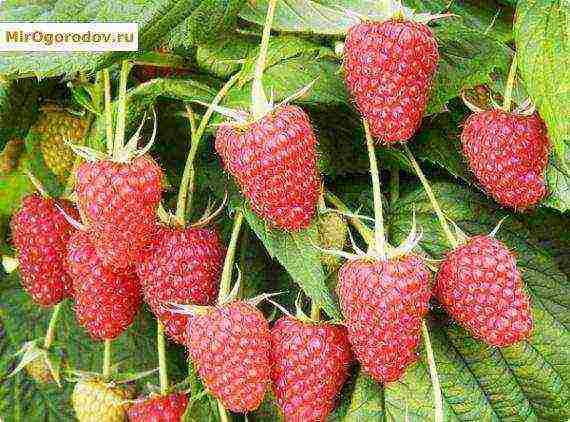
Spectacular and productive Shelf
Eurasia
Repaired raspberry Eurasia is rapidly gaining popularity. The variety is fruitful, drought-resistant, medium early, which allows you to give up all the berries before the onset of frost. Shoots of the standard type are upright, up to 1.5 m high, do not need support. The berries are dark raspberry, matte, sweet and sour in taste, weighing 4–6 g. The dense pulp does not overripe for a long time, remaining juicy, but not friable. Another plus is unpretentiousness to soil and weather conditions.
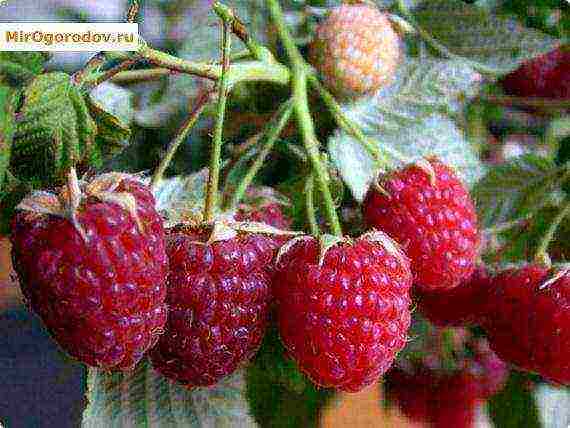
Hardy and productive Eurasia
The list of raspberry varieties, including those for the middle lane, can be continued with no less spectacular representatives. When choosing an assortment, try to have summer and remontant varieties, early and late, elite and the most unpretentious ones in your raspberry-tree - then you will have a harvest regardless of the vagaries of nature.
Video about new varieties of raspberries:
Moscow, Russia, on the site since 11.01.2017
Review of the best varieties of the sweetest raspberries according to gardeners' reviews
Raspberries are a popular and healthy summer berry.Old adapted varieties in Central Russia are distinguished by their unpretentiousness and vitality. On the site, raspberries can even behave aggressively, capturing new territories and expanding the boundaries of the raspberry. This behavior is associated with the characteristics of the varieties and lack of care. The best varieties of raspberries according to reviews of gardeners from different regions are presented in our rating.
Raspberry varieties are conventionally divided into 4 groups: large-fruited, classic, renovation and standard (tree-like).
Large-fruited raspberry inherited from the parental forms a high mass of berries and low winter hardiness. When growing large-fruited varieties of raspberries in the Middle Lane, the shoots are bent down and covered for the winter. To obtain large berries, you will need to create the appropriate conditions: the introduction of organic matter, top dressing, prevention of diseases and pests, regular watering. On poor soils, you cannot get a good harvest, and in a drought, the berries will simply dry out on the branches. The brightest representative of the group, which has many fans and is grown even in the Urals - Krasa Rossii.
Stock raspberrydespite the growing interest in the group, it remains exotic in Russian gardens. These varieties of raspberries are decorative, easy to pick berries, disease resistance and high yield (due to active lateral branching). "Raspberry tree" does not need support, the crown retains its shape under the weight of the berries. At the same time, the varieties show good frost resistance and unpretentious care. Formation consists in pinching the tops of the shoots by 10 - 15 cm. In this group, the Tarusa variety is distinguished.
Classic raspberry varieties bear fruit on the shoots of the last year, so the ripening of the berries begins early: from the end of June to July. Bushes winter with long shoots, which are recommended to be covered in the Moscow region.
Repair raspberry bears fruit on both last year's and young shoots. But experienced gardeners recommend cutting out all the shoots in the winter and getting one late harvest on a young growth. In this case, the yield will be higher and the size of the berries will be larger. Fruiting period for remontant varieties: from late July to September-October. Many varieties of remontant raspberries are well suited for the Moscow region. Their advantages: they overwinter without problems, do not suffer from pests, and are superior in yield.
The choice of the best raspberry variety also depends on the purpose of the raspberry planting: for home use of dessert berries or for the sale of a marketable crop. Commercial varieties are distinguished by high yields, transportability and attractiveness of berries, but inferior in taste.
The best varieties of raspberries according to gardeners' reviews
The best remontant varieties of raspberries
|
Polka 250 (for one year old seedling in a bag with wet moss) A remontant dessert variety of Polish selection. Sprawling bush, 1.6 - 1.8 m high, forms little root growth, gives up to 10 replacement shoots. Shoots are strong, do not bend during fruiting, covered with small, thornless thorns. The berries are dark red, rounded-oblong, with an average weight of 5-6 g, sweet taste, with a pronounced bright aroma, well stored and transported. The yield of one bush, with proper care, exceeds 4 kg. Berries do not crumble, are transported, due to dry separation, they are ideal in freezing. Shows high resistance to gray rot and spider mites, but susceptible to cancer of the measles system. It has low winter hardiness, but with complete mowing of shoots, this disadvantage is not of paramount importance. In arid climates, it behaves badly. This remontant raspberry variety received good reviews from gardeners in the Rostov region and the Moscow region. Main pluses:
Minuses:
|
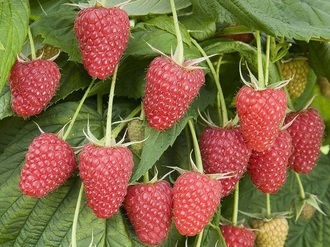 9.8 / 10 Rating Reviews The most delicious remontant berry.In regions with harsh winters, it is best to cut flush with the ground and mulch well.
|
|
Bryansk miracle 270 (for one year old seedling in a bag with wet moss) Repaired raspberry variety for commercial purposes and personal use. It is late in terms of ripening. The bush is 1.5 - 1.9 m high, slightly spreading, the formation of overgrowth is medium. The main shoots are thick with sparse soft thorns; there are no thorns on the fruit branches. The garter is done only in windy areas. Also, due to the long side shoots, the garter contributes to better ventilation and illumination of the lower tier. Berries of classic red color, cylindrical, elongated, up to 3 - 4 cm long, weighing from 5 - 7 to 11 - 20 g. Average yield - 3 kg per bush. The taste is sweet with sourness. The palatability rating is good and excellent. The berries are dense, store well and tolerate transportation. In order for the bush to realize its potential yield, the lower buds are removed, accelerating the ripening of the upper ones and promoting the formation of larger berries. It prefers light fertile soils; on heavy loams, the yield decreases sharply. Average winter hardiness. In winter, it is recommended to mow the shoots to the ground, since the stump left takes away strength from the rhizome and reduces winter hardiness. The variety does not perform well in arid regions. Recommended for the Moscow region and the Central strip. Main pluses:
Minuses:
|
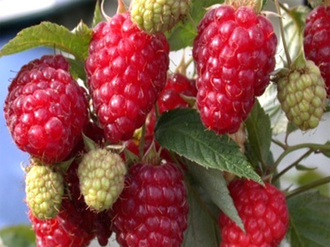 9.7 / 10 Rating Reviews This variety of raspberries fell in love with the late ripening, when only apples were left in the garden. With good care and proper fit, there are no problems with it.
|
|
Orange miracle 250 (for one year old seedling in a bag with wet moss) Repaired variety with orange berries. The bush is medium-sized, up to 1.7 m high, compact. Shoots are erect, heavily spiked, fragile and can break off under the weight of the berries. The formation of fruit branches is active and covers 2/3 of the length of the shoot. The bush forms up to 7 replacement shoots and gives a lot of growth. The berries are cone-shaped, with a slightly pointed apex, dense, even, up to 4 cm long and weighing 6 - 12 g. They have a delicate aroma and sweet taste with a slight sourness. The sugar content depends on the soil and climatic conditions of cultivation and the level of agricultural technology. The berries are well transported; when overripe, they remain on the branches. The yield from one bush reaches 3 kg, while before frost the variety manages to give 70 - 100% of the potential yield. There is a high resistance to pests and an average - to diseases. Dessert berry taste and good transportability make the variety versatile. The variety has shown itself well in the Moscow and Rostov regions, it is recommended for the Central strip, the Urals and Western Siberia. When grown in an annual culture (cutting on a stump in winter), there is no risk of freezing of the shoots. Main pluses:
Minuses:
|
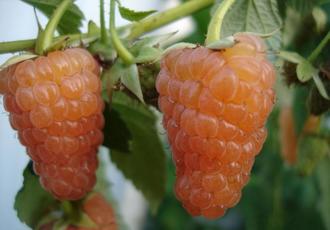 9.7 / 10 Rating Reviews The best sort of remontant raspberry for the Moscow region, in my opinion. The berry is tasty and very beautiful, ripens quickly. If you cut off the unripe berries along with the stalk, then they ripen perfectly.
|
|
Hercules 450 (for a 2 year old seedling in a container) Repaired commercial grade. The bush is 1.6 - 1.8 m high. The shoots are erect, with rigid thorns along the entire length, strong and do not require support. Lateral branching is abundant, shoots are weak (up to 3 - 4 replacement shoots). The variety tolerates thickened plantings well, does not require frequent thinning. Ruby berries, in the shape of a truncated cone, dense, weighing from 6 - 10 to 15 g, with a pronounced aroma. The taste is sweet and sour, refreshing, but in cold weather the sourness is more pronounced. The yield from one bush reaches 4 kg. Differs in high resistance to diseases (including viral) and pests, drought-resistant and winter-hardy. Waterlogging spoils the taste of the berry, making it watery. With a lack of heat and lighting during the ripening period, the berries turn out to be sour, they are good in compotes and jam. This variety of raspberries has adapted well in the Moscow region, the Middle Belt and the Urals, showing stability and unpretentiousness. In regions with cold rains in the second half of summer, it is impossible to get a high-quality berry without additional measures. Main pluses:
Minuses:
|
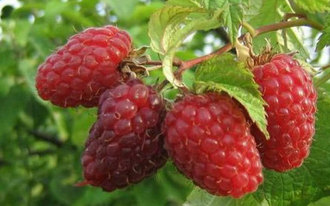 9.5 / 10 Rating Reviews For beginners, this raspberry is the easiest to care for in comparison with other remontant varieties, top dressing and a well-chosen site, it is possible to get delicious berries.
|
|
Firebird 220 (for one year old seedling in a bag with wet moss) Repaired grade for small areas. Gardeners appreciate it for its excellent taste. In terms of yield, transportability and size it loses to other commercial varieties. More often grown for personal use. The bushes are compact, up to 2 m high, forming 5 - 8 replacement shoots. Shoots are covered with soft and thin thorns, to a lesser extent on the upper part. A garter to the trellis is required. Bright red berries of a conical shape with a blunt top, glossy, drupes are large, dense, weighing 4 - 6 g. The yield per bush is 2 - 2.5 kg. Ripe berry does not crumble. If the berries are picked regularly, avoiding overripening, then the harvest is well transported. This raspberry shows good results in the southern regions, but due to insufficient heat resistance it needs mulching and shading. In the northern regions, it manages to realize only 70% of the potential yield. Main pluses:
Minuses:
|
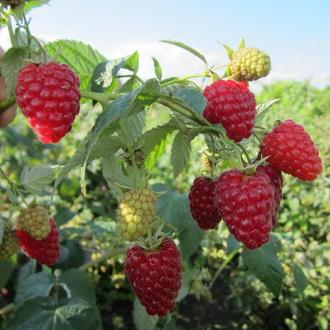 9.5 / 10 Rating Reviews An excellent dessert berry, it does not prick strongly, so the collection of berries is without negative. The care is the same as for other remontant raspberries.
|
The best classic raspberries
|
Kuzmin's news 250 (for one year old seedling in a bag with wet moss) An old classic mid-season raspberry variety that does not lose its popularity. Grown for fresh consumption and processing, not suitable for commercial purposes. Bushes are tall, from 2 to 2.5 m, erect, slightly spreading, they form few root suckers. Gives few replacement shoots. Shoots are arched, drooping. Thorns are long and thin (shorter and thicker towards the apex), cover all shoots, but their number is average. The berries are oblong, dyed red, with an average weight of 2 - 5 g, with a weak aroma. The taste is excellent, but the berries are not suitable for transportation and storage. When ripe, they are easily separated from the stalk, but do not crumble when overripe. On average, 1.5 - 2 kg can be harvested from one bush. In favorable years, repeated fruiting is possible on young shoots. The variety is not picky about soil types and care, but has a low drought tolerance. In the absence of watering, the beginning of fruiting is delayed by 2 - 3 weeks. Poorly tolerates drafts and is susceptible to viral diseases. In general, the variety is characterized as the most hardy and is recommended for "lazy" and inexperienced gardeners. It is grown in all regions of Russia, but is of particular value for the Central belt, the Urals and Western Siberia. Main pluses:
Minuses:
|
 9.5 / 10 Rating Reviews The best raspberry variety for Siberia, for fresh consumption. I have 2 bushes planted especially for children.The overgrowth does not torment, I also don’t fiddle with shelter.
|
|
Yellow giant 300 (for one year old seedling in a bag with wet moss) A classic variety of early ripening yellow raspberries. The bush is powerful, 2 - 2.3 m high. 8 - 10 replacement shoots are formed, but the bush remains compact and does not fall apart. Young shoots without thorns, on old ones - in small numbers. It is prone to strong branching of fruit branches: up to 4 - 5 orders of magnitude. Intensive development of root shoots. The main fruiting is on last year's shoots, but under favorable conditions, a second wave of fruiting is possible at the tops of the young growth. Amber-yellow years are broadly conical with a blunt apex, up to 4 cm long and weighing 8 - 10 g. The yield from one bush is more than 4 kg. Due to poor transportability, they are used only for personal use. In the middle lane, it shows insufficient winter hardiness and requires additional protection. Shoots are flexible and bend easily for winter shelter. Main pluses:
Minuses:
|
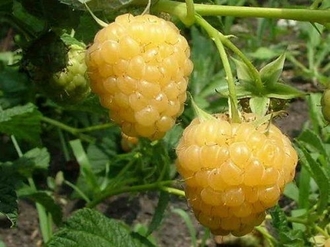 9.5 / 10 Rating Reviews I keep several bushes of this raspberry as a treat. The variety is appreciated for its excellent taste and beautiful berry. Not suitable for sale, processing and freezing.
|
|
Patricia 200 (for one year old seedling in a bag with wet moss) A classic variety of large-fruited raspberries. Spreading bush, 1.5 - 1.8 m high, annually gives 6 - 10 replacement shoots. Forms a lot of root growth, which should be removed in a timely manner. A garter to the trellis is required. Shoots of the first year without thorns. At the end of the season, formative pruning of the shoots is required. Fruiting begins in mid-June and lasts until mid-August. The berries are bright red, cylindrical or irregular in shape, with a velvety bloom, with an average weight of 5 - 6 g (up to 10 - 12 g). Drupes are large, fit tightly. The aroma is pronounced. The average yield is 4 - 5 kg per bush, but it can reach 8 kg. The berries do not tolerate transportation well and are not intended for long-term storage. The variety does not tolerate waterlogging. Recommended for the Central region of Russia, but successfully grown in the Urals. Main pluses:
Minuses:
|
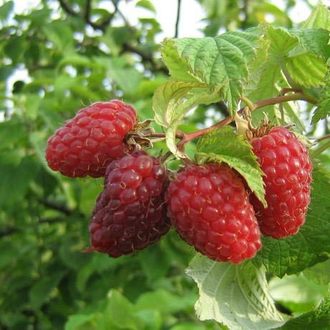 9.4 / 10 Rating Reviews Berries with a very delicate pulp, ideally: pick and eat immediately. With the harvest, raspberries cannot be postponed - overripe berries become moldy and crumble.
|
The best standard raspberry varieties
|
Tarusa 300 (for one year old seedling in a bag with wet moss) Standard raspberry with late ripening. In one season, a branchy tree grows up to 1.8 m high, with thick shoots on a trunk. Shoots are elastic and do not need a garter, there are no thorns. The variety branches beautifully and does not need special labor-intensive pruning. Gives 3 - 4 replacement shoots annually. No more than 10 shoots are left in the bush. Berries are claret-red, sweet and sour, conical or irregular, up to 10 - 15 g, dense and transportable, have a pronounced aroma and are good for processing. Small seeds are almost not felt. Productivity is high: up to 4 kg per bush. Despite the high declared winter hardiness, freezing is observed in the windy area in snowless winters. Grown from the Moscow region to the Urals. In rainy summers, the berries are watery and sour. The taste is strongly influenced by grooming and feeding. Main pluses:
Minuses:
|
 9.7 / 10 Rating Reviews The shoots at Tarusa are powerful, but under the weight of the crop they still sag and can break, so I use a trellis. Good yield, we use it for making jam and jam - it turns out very fragrant.
|
|
Monomakh's hat 270 (for a one year old seedling with a bag of wet moss) Standard raspberry variety with remontant fruiting. The bush is up to 1.5 m high, forms up to 5 powerful branched shoots with drooping tops. The lower part of the shoots has hard thorns. Due to the weak formation of shoots, cuttings are more often used for reproduction. Berries of juicy red color, weighing from 7 to 20 g, pyramidal with a blunt top, sweet with a slight sourness and bright aroma, leveled and mouth-watering. When assembled, they do not fall apart, are suitable for storage and transportation. An average of 4 - 5 kg is harvested from one bush. Reacts painfully to interruptions in watering, tying small berries. The variety has an average winter hardiness. In the northern regions, under conditions of early frosts due to late ripening and extended fruiting, it realizes only 50% of the potential yield. This raspberry variety is good for the southern regions. In the middle lane, it is grown in an annual crop, when in autumn the shoots are cut to ground level. Main pluses:
Minuses:
|
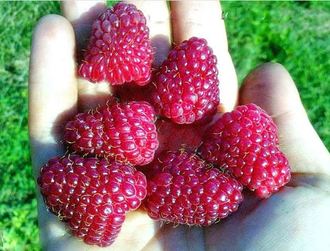 9.3 / 10 Rating Reviews Dessert-tasting berries, neat, fruitful bushes. Raspberries require attention, but this is for all large-fruited varieties.
|
Studying the varietal diversity in the catalogs of online stores or nurseries, one should not forget about acclimatization and varietal testing in new climatic conditions for the variety. If the raspberry variety seems attractive to you and has positive reviews in other regions, then first you should buy 1 - 2 bushes, provide them with better conditions and conduct your own assessment. The taste, the strength of growth, the ripening period are largely determined by the growing conditions: the climatic zone and agricultural technology.
Have a nice harvest!
Attention! The reliability of the information and the results of the ratings is subjective and does not constitute advertising.
Every gardener dreams of eating juicy and large raspberries. Find out which varieties of large-fruited raspberries you can grow on your own site.
The large-fruited group includes raspberry varieties that produce berries weighing 4-12 grams. Some record-breaking berries can reach a weight of about 20 grams.
As a rule, a large-fruited seedling can be distinguished by the elongated sepals of the flower.
1. Hercules
Large-fruited variety of raspberries. The berries have a regular shape, ruby color. They ripen early. In addition, the variety is resistant to most raspberry diseases.
2. Patricia
Winter-hardy large-fruited and high-yielding non-repairable variety. The berries are juicy, aromatic, sweet. Plants are medium-sized, semi-spreading bushes. Berries weighing up to 14 g, have a truncated-conical shape, a beautiful velvety surface. Berries of medium density, have a sweet raspberry aroma. Early ripening variety, bears fruit every year.
3. Bryansk miracle
A compact bush, medium-sized, has large elongated-conical berries, the weight of which reaches 6 g. The variety is high-yielding, 4-5 kg per bush.
4. Bristol Black
Medium bush. The berries are medium in size, black, round, with a whitish bloom. They have a great taste, ripen at the end of July. The plant is weakly susceptible to diseases and pests.
5. Eurasia
One of the remontant varieties. Has large berries, good yield and high early maturity. Berry yield - 2.0-2.5 kg per bush. Differs in resistance to pests and diseases. The bushes give a high yield in various soil and climatic conditions.
6. Crane
A variety of medium ripening, winter-hardy, yield up to 2 kg. The bush is compact, medium-sized. The shoots are strong.Berries are blunt-conical red, have a slight pubescence, sweet-sour pulp, weight 2.7-3.5 g. The variety is resistant to fungal diseases, raspberry mite.
7. Senator
One of the most productive and winter-hardy varieties, which has an average ripening period. Raspberries of this variety yield up to 4.5 kg per bush. The berries are red-orange, conical, very large, up to 7 g, dense. The pulp is juicy, has a sweet and sour taste. The bush is high, the shoots are straight, thornless. The variety is resistant to diseases and pests.
8. Fantasy
A variety that does not have thorns. The mass of berries often exceeds 7 g. It has a weak winter hardiness.
9. Scheherazade
A variety of medium ripening. It is characterized by strong growth and medium spreading of the bush. The berries are large, have a weak aroma, reach a weight of 6 g or more. The yield of the variety is up to 4 kg per bush.
10. Maria
A variety of medium ripening. The berries are large and sweet, weighing up to 4g. They have a deep red color, elongated shape, suitable for processing and fresh consumption.
11. Golden Autumn
The berries have a dense flesh, the yield of the variety is good, it can reach 9 kg per bush. The berries have a pleasant taste, are well stored and transported.
12. Golden domes
A large-fruited variety of raspberries, berries weighing more than 10 g, are colored orange. They have a truncated-conical shape. They give their first harvest in early August.
13. Orange miracle
The berries are large, weighing from 4.5 to 9 g. They have a pleasant sweet taste.
14. Cleopatra
A variety of medium ripening. Vigorous, has dark green wrinkled leaves, sweet raspberry-colored berries, which have a conical shape and a weight of about 5 g. The average yield per bush for both varieties is about 4 kg.
Large-fruited raspberries boast not only large berries, but also high yields. The main disadvantage of these varieties is low winter hardiness and susceptibility to diseases and viruses. But why not give one of these proven strains a shot? It may well be that the results will please you.


